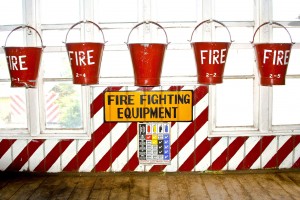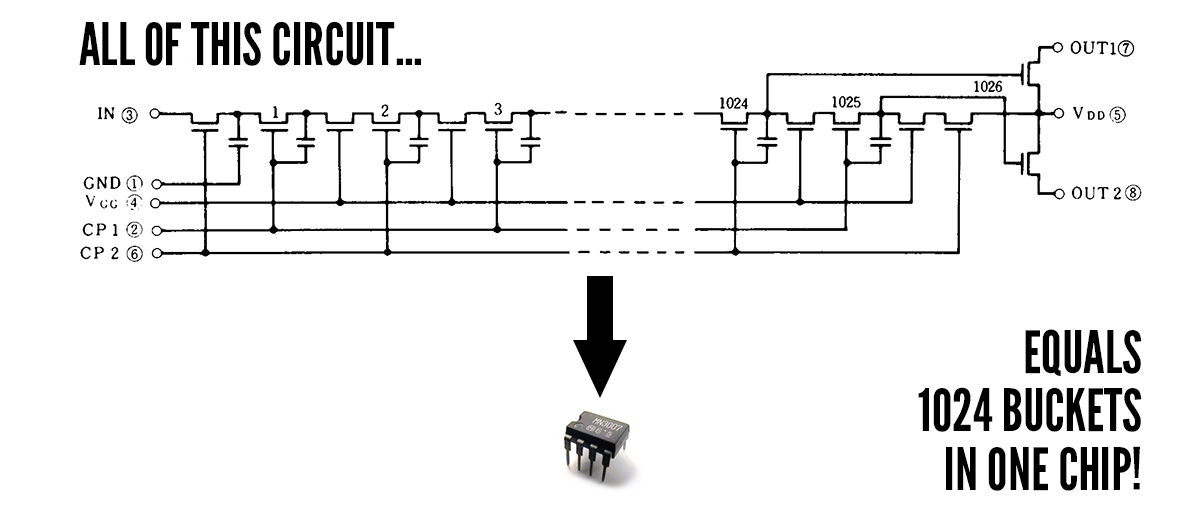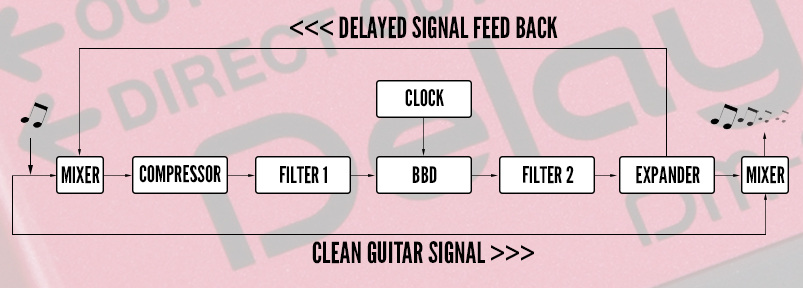In this article, we set out to demystify the analog delay pedal, focusing on the Bucket Brigade Device (BBD), and dispel myths, half-truths, and urban legends surrounding it.
BOSS debuted the first analog delay stompbox in 1981 with the revered DM-2, followed by the DM-3 in 1984. While these pedals are centered around an integrated circuit chip that often sparks debates about “Which BBD is Best?”, it’s crucial to recognize that analog delay involves more than just one chip.
So, what exactly is a BBD? We’re glad you asked…
THE DAWN OF DELAY
Check, check, check… One, one, one… Two, two, two…
No doubt, you have heard the delay effect before. Delay and rock music have shared a rich history; from the first slapback effect heard on Elvis’ “That’s All Right” to the current powerful delay machines gracing the pedalboards of the stars.
Early delay effects originated from tape machines like the iconic Roland RE-201 Space Echo. This involved recording a tape loop, playing it back, and removing the input signal to create a delayed effect.
However, tape delays were impractical due to transport issues and delicate mechanics. The demand for a portable solution led to the development of analog delay and modulation stompboxes, such as the BOSS DM-2 and DM-3. These stompboxes featured the transformative Bucket Brigade Device circuit.
BBDs: HOW DO THEY WORK?

Contained within a small chip, an incoming audio signal is delayed by a Bucket Brigade Device (BBD). This “circuit-within-a-circuit” enabled analog delay in stompbox form. The term “Bucket Brigade” references firefighters passing buckets down a line to extinguish a fire, mirroring the BBD’s function.
The incoming guitar signal is akin to water in a BBD. A series of capacitors inside the chip functions as “buckets” that carry the signal. The continuous filling and emptying of capacitors slow down the signal, causing a delay as it passes through the BBD.
However, more than a single BBD chip forms an analog delay. The design of surrounding circuit “blocks” significantly contributes to the overall sound. A delicate juggling act is faced by engineers, determining whether these circuit blocks make or break a great analog delay tone.

WHY DOES AN ANALOG DELAY SOUND SO WARM AND SMOOTH?
Imagine a line of 1024 firefighters, each passing a bucket of water to each other… that’s a fair amount of spillage. This spillage also occurs in the BBD, adding noise and distortion. Add to that the “ticking” noise introduced by the CLOCK (which we talk about in the technical section). Filtering is required to eliminate this unwanted noise, resulting in a “darker” delay signal than the input guitar signal. This frequency difference creates the desired response for analog delay. The dark repeats fade into the background, allowing your original guitar signal to remain undisturbed.
The characteristic warm, smooth and organic sound of an analog delay is actually due to its limitations and not magic. Although a technically imperfect design, the use of BBD chips have inspired generations of music and artists.
DM-2W and DM-101 – EMBRACING ANALOG DELAY TODAY
Both the iconic BOSS DM-2W and the cutting-edge DM-101 are emblematic of the evolution of analog delay.

The revered BOSS DM-2 Delay pedal, renowned for its warm “bucket brigade” analog delay tone, has made a triumphant comeback as the Waza Craft DM-2. Despite being discontinued in 1984, the DM-2’s lush sound and 20-300 ms delay range continued to be highly sought after. The DM-2W faithfully reproduces the original’s analog warmth with 100-percent analog circuitry. Crafted in Japan, this pedal is part of the Waza Craft series, ensuring exceptional tone and touch response through carefully-selected analog components and refined circuitry.
Joining the league of modern analog delays, the DM-101 Delay Machine takes inspiration from the 1970s BBD-based delays. With its warm, saturated, and highly musical sound, the DM-101 employs modern CPU control to supercharge this classic effect, providing enhanced capabilities tailored for today’s music makers.
LET’S GET TECHNICAL! [ADVANCED SECTION]
Are you ready for some nerdy analog-delay, electronics talk? This section goes deep into the analog delay circuit to understand each of these circuit blocks.
In order for a BBD to work, it requires additional circuit blocks. To understand the circuit, let’s follow the block diagram below from input to output
► INPUT MIXING CIRCUIT – the guitar signal is split into two signals: One signal goes straight through to the COMPRESSOR block. The other split signal goes through to the OUTPUT MIXER STAGE. The signal going through to the BBD must have low distortion, low noise and have a narrower bandwidth in order for the BBD to work efficiently. That’s where compression and filtering comes in.
► COMPRESSOR (COMPANDER) – A guitar signal has a wide dynamic response with a range of low output and high output peaks dependent on your style of playing. The BBD doesn’t like this response so the signal is compressed to maximise the amount of gain of the signal going into the BBD. This helps reduce distortion on the repeats while keeping noise as low as possible (maintaining a good signal-to-noise ratio).
► FILTER 1 (ANTI-ALIASING) – BBDs don’t like high-frequency audio as it can introduce aliasing artefacts into the delayed signal. A low-pass filter rounds off the troubling high frequency, making the signal ready for the BBD.
► BBD – You know all about this now! A series of “buckets” that pass audio from one to the other creating that time-delay effect. Refer to the “BBDs! HOW DO THEY WORK?” section.
► CLOCK – Think of the clock as a metronome: A constant ticking pulse that tells the BBD to move the audio from one stage (bucket) to the next. The RATE knob on the delay pedal controls the speed of the clock. A fast rate means a slapback delay, a long rate means a long delay time.
► FILTER 2 (RECOVERY) – the signal output from the BBD is now a sampled signal and needs to be “smoothed” out in order for the EXPANDER section to work efficiently. In addition, the CLOCK circuit introduces a “ticking” noise whenever the pedal is on. Applying another low-pass filter helps reduce the clock noise and smooths out the signal for dynamic range expanding.
► EXPANDER – As opposed to the COMPRESSOR stage, the expander takes the delayed signal from the BBD and expands the dynamic range as close as possible to the initial input signal. The signal response is now very similar to the original input signal but has a darker tone as it has passed through two filters.
► FEEDBACK – a portion of the delayed signal is now split off and “fed back” into the compressor stage. This feedback is what creates the trailing echo effect. More signal fed back means more repeats, controlled by the INTENSITY control. Too much signal fed back into the circuit leads to oscillation – that awesome space-ship effect that is a signature sound for analog delays.
► OUTPUT MIXER – The original split guitar and the darker delayed signal are mixed together, with the blending of the two signals (“wet” for delayed signal, “dry” for the original signal) controlled by the ECHO knob.
That’s it. You have just powered up to “Circuit Guru!”.
There is much more to an analog delay than mojo, or the number written on a BBD chip. It is more about the detailed engineering design that goes around it that gives the delay the character it is known for. So when you next get lost in those rich, dark repeats of your analog delay, hopefully you can appreciate the amount of work that has gone into giving you your favourite delay effect.
This article was originally contributed by Christian Moraga for the Roland Australia Blog and has since undergone updates and modifications




